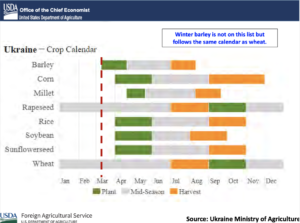Bloomberg's Clarice Couto reported this past Friday that "a surprising tax change in agriculture powerhouse Brazil has the potential to make soy grown in the world’s largest bean exporter less…
Ukraine Increases Spring Planting Forecast
Reuters writer Pavel Polityuk reported yesterday that, “Ukraine’s agriculture ministry on Friday revised up its forecast for the area to be sown to 2022 spring crops, giving no reason for the new outlook.
Around 14 million hectares of various grains, cereals, and oilseed might be sown this year, compared with the previous forecast of 13.4 million hectares, the ministry said in a report.
“The acreage is still smaller than in 2021 due to hostilities in some Ukrainian regions cause by the Russian invasion. Ukraine sowed a total of 16.9 million hectares of spring crops in 2021.”

Polityuk pointed out that, “The ministry said farmers had already started sowing spring wheat, barley, peas, sunflower, rape seed, sugar beet, and soybeans.
“It said farmers had sown 146,400 hectares of spring wheat, 742,900 hectares of spring barley, 100,500 hectares of peas, 122,600 hectares of corn, 433,700 hectares of sunflower, 110,300 hectares of sugar beet and some other crops.
“The ministry gave no exact expected sowing acreage for each commodity.”
And Bloomberg News noted yesterday that, “Ukraine said its spring planting outlook has improved slightly as Russia’s military narrows its focus to the country’s east.”
Meanwhile, Reuters writer Pavel Polityuk reported yesterday that, “Around 1.25 million tonnes of grains and oilseeds are still on commercial vessels blocked in Ukrainian seaports due to Russia’s invasion and part of the cargo may deteriorate in the near future, Ukraine’s farm minister was quoted as saying on Friday.
“Ukraine used to export almost all its grain and oilseeds via seaports and now is forced to find new routes as its ports are blocked.
“Before the war, Ukraine exported up to 6 million tonnes of grain and oilseed a month, while in March the exports fell to 200,000 tonnes, Mykola Solskyi told the newspaper Ukrayinska Pravda.”
World's largest #wheat exporters in 2020.
— Farm Policy (@FarmPolicy) April 14, 2022
From today's @YeutterUNL webinar, "Turmoil in Commodity Markets." pic.twitter.com/2pj1Xw0Why
Also this week, in a column posted at Time Magazine Online, farmdoc’s Scott Irwin indicated that,
The big question is whether the impact of the Ukrainian conflict on global grain supplies is likely to be similar to a severe drought or something much worse?
“There is definitely the potential for the latter. A drought typically does not zero out entirely crop acreage in a major producing country. This is where the timing of the Russian invasion is so important. The planting window for spring crops in Ukraine is basically the same as it is in the U.S. Corn Belt—April and May. Once the war started on February 24th it was easy to see it spilling into the spring planting season and severely affecting the ability of Ukrainian farmers to get their crops in the ground. The fear was that little, or even none, of Ukraine’s spring crops would be planted.”
The Most Vulnerable Countries Amid #Wheat Shortages.
— Farm Policy (@FarmPolicy) April 14, 2022
From today's @YeutterUNL webinar, "Turmoil in Commodity Markets." pic.twitter.com/VcVZqv3qD0
Irwin noted that, “The Ukrainian Agricultural Ministry surprised many by saying that it expects 70% of spring crops to be planted, and up to 80% if ‘de-mining’ is completed in northern areas previously occupied by Russia. While this can probably be discounted as having an optimistic bias, I think this is an important perspective that should not be dismissed out of hand. While all of Ukraine’s spring crops are obviously not going to get planted, this suggests the worst-case scenarios of just a few weeks ago are not likely to happen. I think it is now safe to assume that at least half of Ukraine’s spring crops will be planted, and I will not be surprised if two-thirds or more is planted. If there is one thing farmers around the world love to do, it is to plant their crops. If there is a way, they will figure out how to get it done.”
“So, is the world facing a full-blown food crisis brought on by the conflict between Ukraine and Russia? Based on what I see today, I don’t believe that is the case,” Irwin said; adding that, “World grain markets are in the process of sending signals to producers and consumers to make needed adjustments, hence the higher prices. If Ukrainian farmers get as much of their crops planted and harvested as I think they will, then the shortfall in production will not be as severe as was feared.”
Irwin stated that, “While the world may avoid a food production crisis, there is likely to be a food affordability crisis in parts of the world.”
“Finally, we cannot forget the role that Mother Nature will play in all this. If there was ever a summer when the world needs good weather in important crop producing areas around the globe, this is it,” Irwin said.







